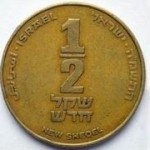Two sides to the shekel – Ki Tissa
 Counting people is a problem for Jews.
Counting people is a problem for Jews.
Some ascribe a superstitious origin to the traditional reluctance to give individuals a number. In time of plague, the victims were counted. No-one wants to be next in line for disease and death.
Others say that if a person is nothing but a number, they have been shorn of all personality and uniqueness and reduced to being carbon copies or clones of everyone else.
Hence various alternatives are used to avoid directly counting human beings. We do not count to see if we have a minyan: we use a Biblical verse which has ten words.
Ancient Israel they had a different method, as depicted in today’s sidra. They needed a census in the wilderness, and each male had to bring half a shekel to the sanctuary. The half-shekels were counted, and this indirectly enumerated the community.
A question arises: why choose half a shekel and not a complete shekel as each person’s mark of identification?
Answer: possibly in order to teach an ethical lesson.
Who is the individual-an entire world or only half a world? There is a good argument in favour of each option. But ethically it may be that we are being told that no-one is totally self-sufficient. I am me, you are you – but I cannot manage without you and you cannot manage without me. Human beings are interdependent.
Each of us is half a world and cannot be complete without the other.



